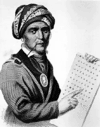|
Big Eagle's Y-INDIAN MEDALLIONS |
|||||
|
|||||
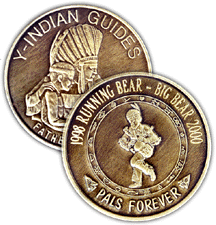
|
Big Eagle's Y-INDIAN MEDALLIONS |
|||||
|
|||||

Charlie, then a commercial photographer, was making a photo of a commemorative medal for the United States Postal Service when he had the idea. Photos and paintings of American Indians sometimes showed them wearing a leather, bone or stone medallion around their necks. Why not make a commemorative medallion for Y-Indian Guides? It could be a part of a little brave's costume while he is in the program and later become a keepsake for mom or dad.
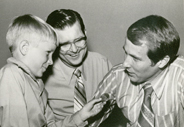

On the reverse was an activity scene, showing a father and son in a canoe. They are dressed in everyday clothes rather than Indian attire. This was to stress that the companionship fostered by Y-Indian Guide experience carries over to other aspects of the boy's life with his father. (In 1971, only fathers and sons participated in the program.)
The slogan of the Y-Indian Guides program,
"Pals Forever", is found at the bottom of the circle
under the activity scene. To complete the story, and make it a
very personal keepsake, a flat space around the medal, above the
slogan, can be engraved with a personal message, usually the name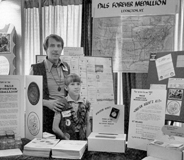 s of child and parent.
s of child and parent.
Photo at right shows Little Eagle and
Big Eagle manning the Pals Forever Medallion
exhibit at the Pittsburgh Y-Indian
Guide National Longhouse, in 1972.
For the first 14 years the activity scene on the reverse was changed and dated each year. In 1985, to eliminate the need to have expensive new dies cut each year, the reverse of the Pals Forever Medallion was standardized with a scene of a little dancing Indian Brave. In a circle around the little brave is a little story, told in American Indian sign language, of a child's journey through life with a parent. The medallion carries that scene today.
In later years, as the Y-Indian Guide concept
expanded to include mothers and daughters, new medallions were
struck for Y-Indian Braves (mother and son), Y-Indian 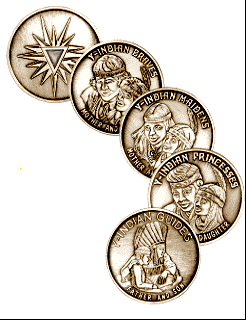 Maidens (mother and daughter), Y-Indian Princesses
(father and daughter).
Maidens (mother and daughter), Y-Indian Princesses
(father and daughter).
The Y-Indian Braves (mother and son) medallion carries the shame reverse scene as the Pals Forever Medallion. The Maiden and Princess medallions have a similar scene on the reverse, but depicting a little dancing Indian girl.
Because of the increasing popularity of the Y-Indian Programs, these medallions have been as much in demand as the original Pals Forever Medallion.
And finally, the Trails Together Medallion for the Y-Indian Family programs completed the set. This medallion has the YMCA Trails Together logo on the front and a family group on the reverse. It can also be personally engraved
